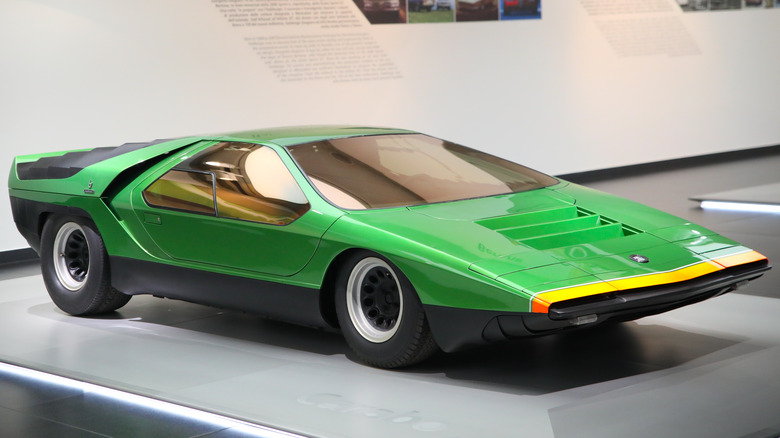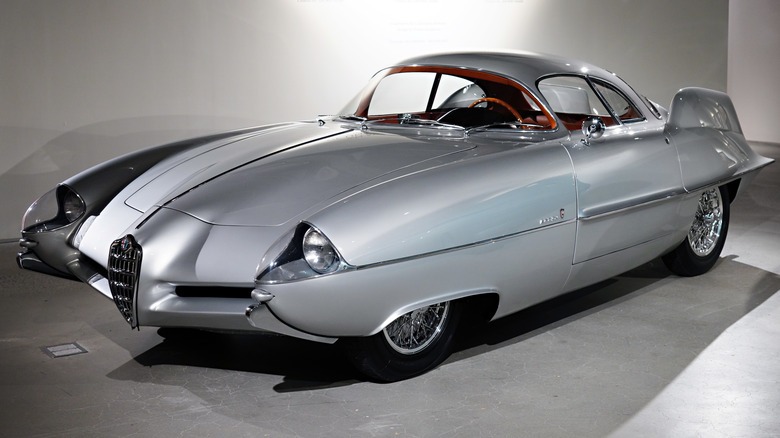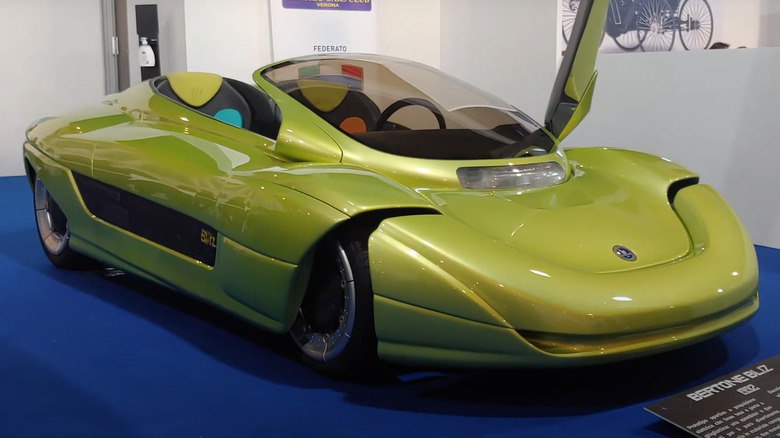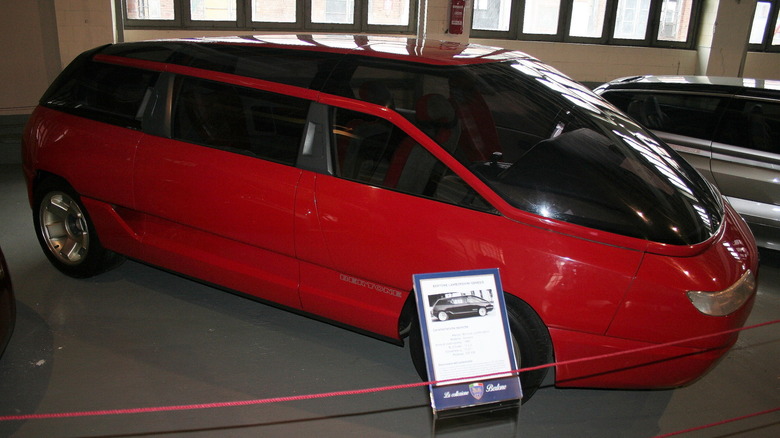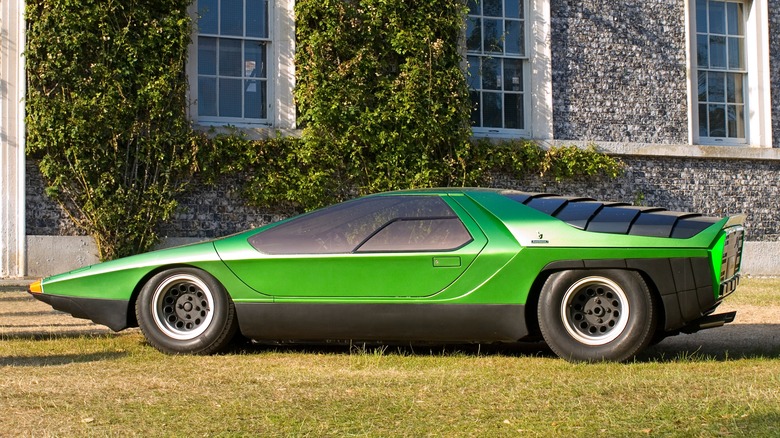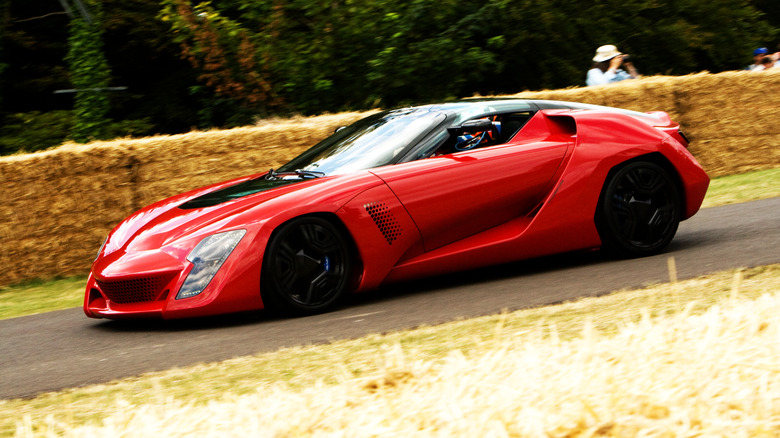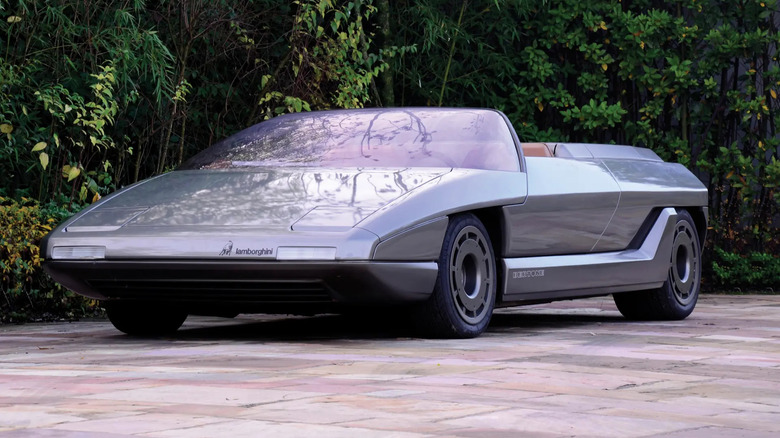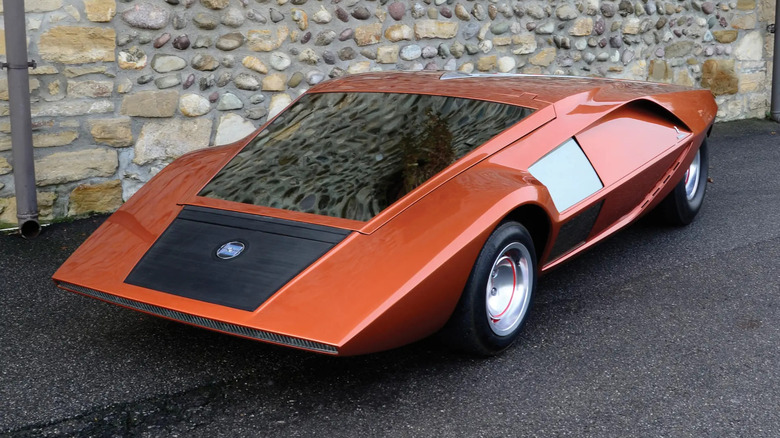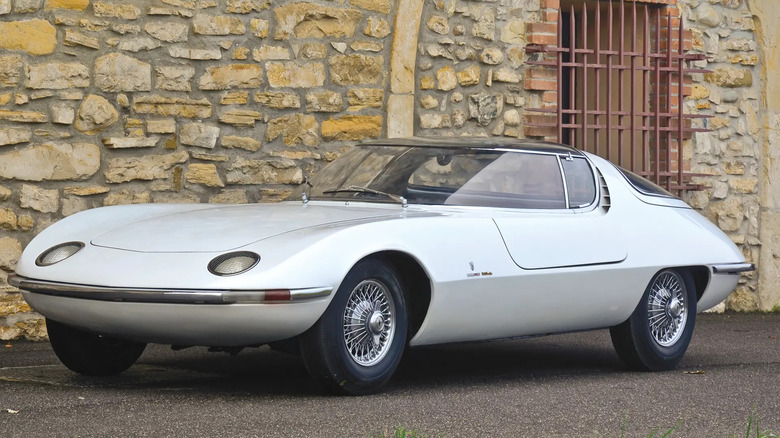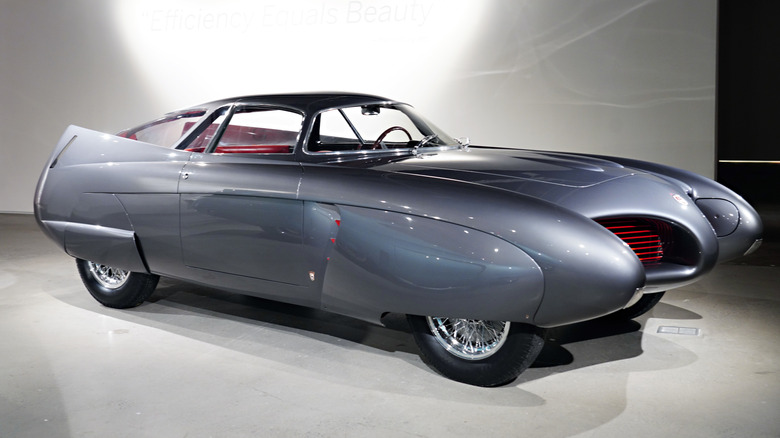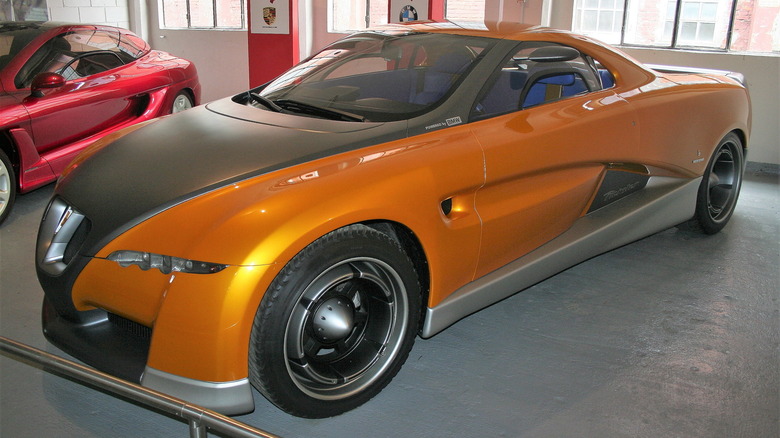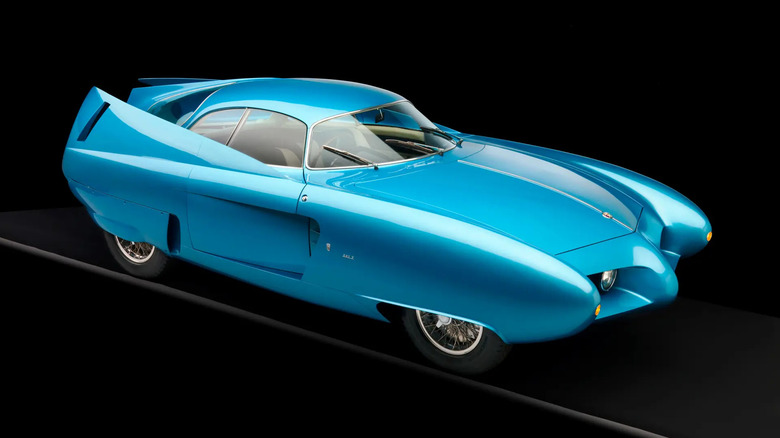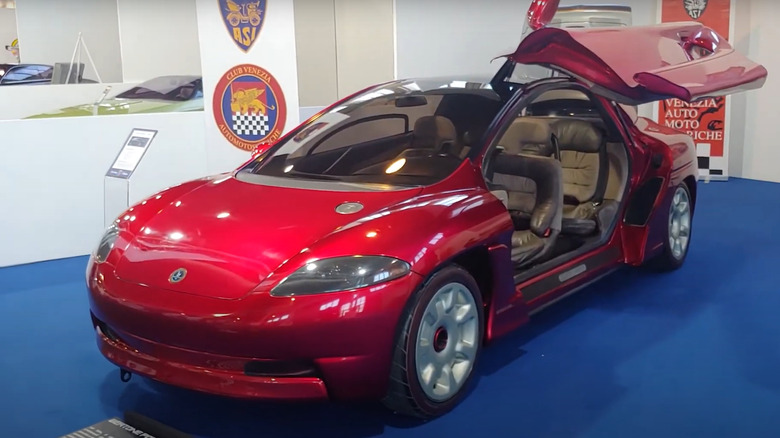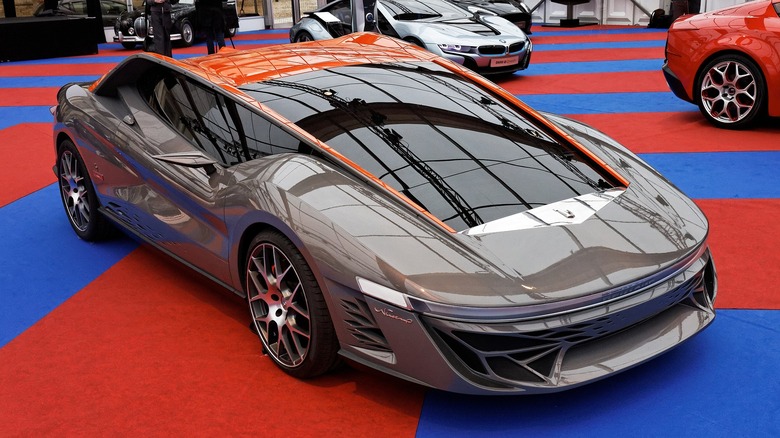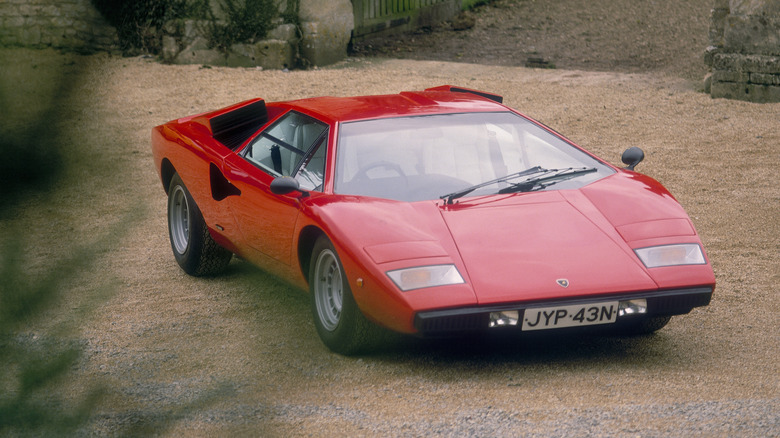14 Of The Most Unusual Looking Cars Designed By Bertone
From its humble roots in the coach-building business to its glory days as one of the world's most respected design houses, Bertone's rise was a remarkable one. Its fall was equally dramatic, with things at the company quickly falling apart after Nuccio Bertone, son of its founder Giovanni Bertone, passed away in 1997. By 2013, what remained of the company had folded.
Bertone has now been resurrected by new investors, who have unveiled the GB110, a high-tech hypercar fueled on plastic waste. It's a unique concept, but it remains to be seen whether it will reach production. Its powertrain might push the boundaries, but the hypercar's design is fairly conservative, at least by historical Bertone standards. At its peak, the Italian outfit was known for its pioneering, head-turning designs, many of which went on to become highly influential. It took pride in delivering unique vehicles, and most were fully functional despite their otherworldly looks. These picks cover a selection of the brand's most unique designs from decades past, some of which were hits and some of which have been long since forgotten about.
Alfa Romeo BAT 9d
The last of a trio that would make up Bertone's groundbreaking Berlina Aerodinamica Tecnica series, the Alfa Romeo BAT 9d debuted in 1955. The previous two cars in the series had generated a huge amount of publicity for both Alfa Romeo and Bertone, with the former initially responsible for arranging the collaboration. However, the automaker's bosses did have one issue with the previous show cars, namely that they weren't immediately identifiable as Alfa Romeos. As a result, they instructed Bertone that the last car in the series should have some resemblance to the brand's road-going models.
The Bertone designer in charge of the project, Franco Scaglione, complied with the request, but barely. The car's headlights, grille, and front-mounted logo made it just about as recognizable as an Alfa Romeo, but the rest of the car was a radical departure from any of the brand's road vehicles. Scaglione had previously worked as a fashion designer, and he brought the same elegant, flowing curves that Italian fashion houses favored into the world of automotive design. He also had experience in the aeronautics industry, and the BAT series took some of its aerodynamics knowhow from that previous experience.
Bertone Blitz
There are many great-looking electric cars on today's market, alongside plenty that are not so visually appealing. However, almost none of them, good or bad, are quite as attention-grabbing as the Bertone Blitz. Unveiled in 1992 as a vision of the zero-emissions future, the Blitz was a dual motor electric sports car that prioritized lightweight construction. It weighed 1,430 pounds, far less than any modern EV, with its bodywork and interior made from a mix of fiberglass and carbon fiber.
Two examples were made, with the exterior design differing slightly between both. The green example pictured above features a cyclops-style headlight and a multi-colored interior, while the second, silver car features a split headlight design and a blue accented interior. The silver car remained in Bertone's collection until the company's bankruptcy, and was eventually bought as part of a group of 79 historic Bertone cars by ASI (L'Automotoclub Storico Italiano).
Lamborghini Genesis
The stereotypical minivan image is one of sensibility, practicality, and everyday driveability. Then there's the Bertone-designed Lamborghini Genesis minivan, which is the polar opposite of all those things. To be fair, Bertone designed the Genesis to eliminate many of the practicality issues inherent with Lamborghini's supercars, including the limited room for passengers and cargo and lack of visibility for the driver. But, the final product is still a long way from being sensible or particularly practical.
The Genesis featured gullwing doors at the front and a sliding door at the rear, and could seat four people. The interior was befitting of a Lamborghini, being much more luxurious than any production minivan on the market. Among those luxuries were the unique Alcantara-trimmed seats that were integrated with the cabin floor. The van was powered by a 455 horsepower 5.2L V12 engine borrowed from the Countach, and was mated to a Chrysler-sourced TorqueFlite automatic transmission.
Lamborghini ultimately decided not to put the Genesis into production, and the sole prototype vehicle remained in the collection of Bertone until it was auctioned off following the design house's bankruptcy.
[Featured image by Andrea Volpato via Wikimedia Commons | Cropped and scaled | CC BY-SA 2.0]
Alfa Romeo Carabo
The Carabo would turn out to be one of Bertone's most influential concepts, although most of the vehicles to borrow its styling wouldn't wear an Alfa Romeo badge. It was originally conceived as a way to use a leftover Alfa Romeo Tipo 33 race car chassis, with the automaker giving it to Bertone complete with the race car's engine and internals. Bertone decided to task Marcelo Gandini, who was employed at the studio at the time, with styling the concept. His distinctive wedge design was intended to reduce front end lift, improving the car's handling and stability.
Since Alfa Romeo had thrown in the engine along with the chassis, Bertone saw no need to change it much, although it did detune the car slightly from its race-ready state. It still made 230 horsepower, which when it debuted in 1968, was an impressive figure for a car so low and lightweight. The Carabo's unusual styling turned heads upon its debut, but it ultimately wasn't enough to convince Alfa Romeo to consider a production car of a similar shape. However, the Carabo's unprecedented wedge styling would be reused by Bertone for several later models and copied by other Italian design houses.
It's possible to trace the styling roots of all the wedge-shaped cars of the '70s and '80s back to this one transformative concept, even though Alfa Romeo itself was never as keen on the shape.
Bertone Mantide
By the time the Bertone Mantide was unveiled, the outfit's glory days were behind it. Nuccio Bertone's family had taken over the running of the company after his passing, but had failed to secure any significant contracts with automakers and quickly ran out of funds. Bertone's factory was sold off to Fiat after the former declared bankruptcy in 2007, but the Bertone design studio remained intact. It was from this studio that the Mantide emerged in 2009, being based on the Corvette ZR1. It borrowed some styling influences from Bertone's earlier designs, including the Alfa Romeo BAT series, but the final product was still unlike anything the company had made before.
A number of unusual styling quirks can be found on the car, including the front grille and side vents, which are both cut out from the car's body panels and feature small hexagonal holes. The rear fenders also rise above the main body of the car, creating a gap for air to pass through. The engine cover of the supercharged LS9 is also visible from the outside thanks to a see-through panel in the center of the hood.
At the time of its launch, there were reports that Bertone was to build as many as 10 examples of the car, but only one functional example is known to exist. It appeared at a specialist supercar dealer in the U.S. in 2019 with a price of $595,000.
Lamborghini Athon
The first Bertone product to emerge after the great Marcello Gandini left the studio was the Athon, a concept based on the underpinnings of the Lamborghini Silhouette. It kept all of the donor car's mechanicals, including its 260 horsepower V8 engine, but featured a unique body that followed the wedge-shaped styling trend that Bertone had helped create with the Alfa Romeo Carabo. The Athon name was adapted from Egyptian mythology and referred to a cult of the sun, a tribute to the car's open-top nature.
Lamborghini didn't put the Athon into production, partly as a result of its financial situation, but the concept's Campagnolo-built wheels were borrowed for the Jalpa. The Athon remained in Bertone's official collection in its original state for three decades after it was first unveiled in 1980, eventually appearing for auction at RM Sotheby's after Bertone entered bankruptcy. It sold for €347,200 (around $480,000 at the time), which seems like quite a deal for a one-off, fully functional Lamborghini concept. It has since made occasional appearances at prestigious events including the 2016 Villa D'Este Concours, where it received a trophy for the most exciting design.
Lancia Stratos HF Zero
Another unusual looking Bertone concept that appeared at an RM Sotheby's auction in the wake of the Italian studio's bankruptcy is the Lancia Stratos HF Zero, a predecessor to the iconic Lancia Stratos. At least, a predecessor in the loosest terms: While it wears the name of the production car, almost nothing is shared between the two. In fact, the Stratos HF Zero was mostly built from Lancia Fulvia HF parts, with the engine, sub-frames, and suspension all borrowed from a crashed example of the road-going car.
The concept's custom chassis was built in-house by Bertone, and allowed the car to sit shockingly low to the ground. The whole car is only 33 inches high, lower than rival wedge-shaped concepts from Pininfarina and Italdesign. This required some creativity in regards to cabin entry, since the car was too low to feature conventional doors. Instead, the entire windshield lifted upwards to allow the driver entry to the car, with the black panel on the hood being made of rubber and acting as a mat for the driver to step on to get in.
While, for obvious reasons, Lancia bosses never considered putting the Stratos HF Zero into production, they did enlist Bertone to help design a production road car with the same low-slung, wedge-shaped principles as the concept. That road car was the production Stratos, which would help propel Lancia into the global spotlight thanks to its distinctive looks and rallying success.
Chevrolet Testudo
Most of Bertone's design work came from Italian carmakers, but in the early '60s, the studio received a commission from GM to create a car based on the Chevrolet Corvair that would appeal to European tastes. GM was considering launching the car in Europe, but wanted something visually distinct from its American counterpart. That idea was eventually dismissed, but not before Bertone had developed the Chevrolet Testudo, a one-off based on Corvair running gear.
The name "Testudo" was derived from the Latin word for turtle, and it's easy to see the amphibian influences in the concept's design. Turtles perhaps aren't the first animals most car designers would think to take inspiration from, but then Giorgetto Giugiaro wasn't most car designers. The Testudo is one of the earliest examples of his work, and with its rounded, shell-like appearance, it's one of his most unusual creations to boot. The car was damaged during a film shoot a few years after its unveiling but was later restored. It remained in Bertone's collection until 2011, when it appeared for sale at RM Sotheby's.
Alfa Romeo BAT 5
The BAT 5 was the first of the three BAT concepts to be produced, having been commissioned at the request of Alfa Romeo. Like the later cars, it used the underpinnings of the Alfa Romeo 1900 as the starting point for its design, but took on a wild-looking appearance that was influenced by its designer Franco Scaglione's previous experience in the aeronautical industry. It was termed the BAT 5 as it represented the fifth evolution of the initial design, with Scaglione tweaking the car's lines each time for maximum slipperiness and visual impact.
The car was unveiled in 1953 at the Turin Auto Salon, and after its time on the show circuit was done, it was sold into private ownership. Its first owner was Stanley "Wacky" Arnolt, a notable American importer of exotic cars, and he reportedly used it as his personal car for a number of years. It then passed through several more American owners over the following decades before being eventually united with the later cars in the BAT series.
BMW Pickster
BMW has never made a production pickup truck, although it has made several one-offs, with the most recent being the luxurious X7 Pickup. Back in 1998, Bertone unveiled its interpretation of what a BMW pickup could look like, and christened it the Pickster. It was created as a statement of intent by Bertone — the Italian outfit was already contracted to produce the C1, a strange-but-cool BMW motorcycle with a fixed roof, and it wanted closer collaboration with the German automaker.
The Pickster was intended to win over bosses at BMW's carmaking division, but that didn't happen. It sourced its running gear from BMW's parts bin, including its 3.2L straight-six engine, but featured a body unlike any production BMW. Its two-tone orange and black bodywork was sculpted more like a sports car than a traditional pickup, with its bed being shallow and impractical. It certainly looked unique, but it's arguably one of Bertone's less-well-aged designs, and it's easy to see why BMW wasn't swayed by the proposal.
[Featured image by Andrea Volpato via Wikimedia Commons | Cropped and scaled | CC BY-SA 2.0]
Alfa Romeo BAT 7
The second entry in the Alfa Romeo BAT trio is perhaps the most radical, with even more aerodynamically refined bodywork that gave it a lower drag coefficient than a Tesla Model S, according to RM Sotheby's. It debuted in 1954, the year after the original BAT 5, and featured distinctive curving rear fins and a lowered front end. Much like its predecessor, it toured the show circuit both in Europe and in America, and was then sold off to a private owner shortly afterwards.
The car bounced through several owners over the following decades, eventually being purchased by a collector in 1986 and subsequently restored. Three years later, the Pebble Beach Concours d'Elegance exhibited all three BAT cars together for the first time, with Nuccio Bertone in attendance. All three were later bought by a single collector, who offered them for auction at RM Sotheby's in 2020. The trio fetched an extraordinary hammer price of $14.84 million at that auction.
Porsche Karisma
Built on the bones of the 993-era 911, Bertone's Porsche Karisma was its answer to a question that had been bothering Porsche for decades. How do you build a roomy four-seater luxury car that still looks, drives, and handles like a Porsche? The German automaker had attempted to answer that question itself with the development of the 989, but spiraling costs had seen the project aborted. The Karisma was designed after the news of the 989's axing, with Nuccio Bertone reportedly keen not to tread on Porsche's toes while it had its own car still under development.
The Karisma was built independently by Bertone without any input from Porsche, and looks very different to any production Porsche of the era. Its rear-engined nature resulted in the concept looking larger from the rear than it did from the front, and meant there was no luggage space. The interior was reportedly spacious, however, and the car's pair of gullwing doors added an extra dash of show car flair to the design. Likely discouraged by the failure of the 989 project, Porsche never considered adapting the Karisma for production, and so only one example was ever built.
Bertone Nuccio
Unveiled as a tribute to Nuccio Bertone, the man responsible for turning Bertone into a globally recognized design house, the Bertone Nuccio concept could have marked a turning point for the brand. By the time it was revealed in 2012, the company was already in deep financial trouble, with Bertone's manufacturing division having already been sold off to Fiat a few years prior. The design studio was also running out of cash, but the Nuccio concept gave it some much needed publicity.
It was an unusual-looking car with a long, sloping windshield that appeared as if it was fading into the bodywork of the car and a roof that was higher at the edges than it was in the middle. The model that debuted at Geneva in 2012 was non-functional, but a month later, the company announced that it was making a functioning version with a 4.3L V8 engine and had already found a buyer for the car in China. The positivity didn't last long, and by 2013, Bertone had run out of funds altogether and collapsed into insolvency.
[Featured image by Thesupermat via Wikimedia Commons | Cropped and scaled | CC BY-SA 3.0]
Lamborghini Countach
While many of Bertone's most outlandish designs remained as concept cars or one-offs, occasionally some of those pioneering cars did make it to production. Perhaps the most famous of all is the Lamborghini Countach. The car's distinctive wedge shape is reminiscent of the Lancia Stratos Zero and Alfa Romeo Carabo, both of which were reportedly used by Bertone as reference points during the Countach's creation. The original Countach design was penned by Bertone's Marcello Gandini but would be tweaked over the decades, with the 25th Anniversary edition looking notably different to the original thanks to some updates by a young Horacio Pagani.
Still, the fundamental wedge design always remained the same, and in the process, it became arguably the most iconic car of its generation. It cemented Lamborghini's place as one of the world's premier carmakers, rivaling even the Miura in its appeal among collectors. It might be one of Bertone's most unusual looking designs, but the Countach is also arguably its greatest.
